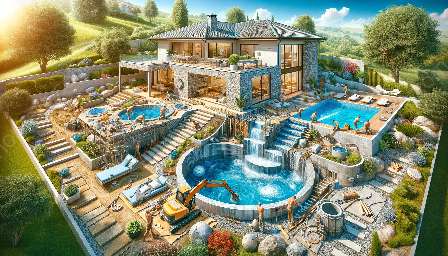As one embarks on the journey of building a spa, it's essential to understand the significance of the materials used in spa construction. From the foundational elements to the finishing touches, every material has a critical role in creating an environment of relaxation and rejuvenation. In this comprehensive guide, we'll delve into the various materials used in spa construction, exploring their unique properties and the considerations that make them integral to the construction process.
1. Foundation and Structural Materials
Spas, much like any other construction project, require a solid foundation. The choice of foundation material varies based on factors such as local soil conditions, seismic activity, and desired spa design. Common materials for spa foundations include concrete, reinforced steel, and compacted gravel. These materials provide stability and support, ensuring the structural integrity of the spa.
The structural components of the spa, including walls, floors, and beams, rely on high-quality materials to withstand the constant exposure to moisture and fluctuating temperatures. Pressure-treated wood, stainless steel, and masonry materials are often used to reinforce the structural elements, offering durability and longevity.
2. Water-Resistant and Insulating Materials
Given that spas involve water activities, selecting materials with high water resistance is paramount. Waterproofing membranes, sealants, and coatings play a crucial role in preventing water infiltration and protecting the spa's structural integrity. Additionally, insulating materials such as foam boards and spray foam help regulate the spa's temperature and conserve energy, enhancing the overall comfort and sustainability of the facility.
3. Surface Finishes and Decorative Materials
The surface finishes of a spa are key in creating a welcoming and aesthetically pleasing atmosphere. Tiles, natural stones, and non-slip coatings are popular choices for spa surfaces, providing durability, easy maintenance, and visual appeal. Decorative materials such as mosaic tiles, artistic glass features, and custom-designed artwork add a touch of luxury and personalization to the spa environment.
4. Mechanical and Electrical Materials
Behind the scenes, an array of mechanical and electrical materials ensure the functionality and safety of spa operations. Pumps, filters, and piping systems made from corrosion-resistant materials like PVC, stainless steel, and fiberglass-reinforced plastics help maintain water circulation and hygiene. Electrical components, including wiring, control panels, and lighting fixtures, are carefully selected for their robustness and compliance with spa-specific safety standards.
5. Sustainable and Eco-Friendly Materials
With the growing emphasis on sustainability, spa construction has seen a shift towards incorporating eco-friendly materials. From responsibly sourced wood for decking and furniture to energy-efficient lighting and heating systems, the use of sustainable materials aligns with the eco-conscious preferences of spa clientele. Additionally, incorporating green building materials like recycled glass tiles and natural fiber fabrics demonstrates a commitment to environmental stewardship.
6. Maintenance and Safety Materials
Lastly, spa construction entails the use of materials that facilitate maintenance and uphold safety standards. Anti-slip mats, non-toxic cleaning agents, and durable waterproofing sealants are essential for ensuring a hazard-free environment. Moreover, signage materials, including safety instructions and regulations, contribute to the overall safety and compliance of the spa facility.
As the spa industry continues to evolve, the choice of materials in construction becomes increasingly crucial in delivering exceptional experiences for spa-goers. By carefully selecting and integrating the right materials, spa builders can create serene and long-lasting environments that cater to the needs of discerning clientele.


